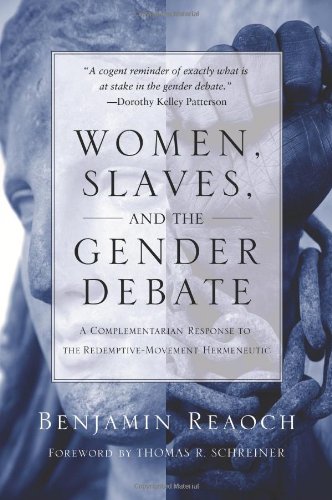A Book Summary from Books At a Glance
About the Author
Dr. Benjamin Reaoch is pastor of Three Rivers Grace Church in Pittsburgh, PA. He is a graduate of Wheaton College, with advanced degrees from Southern Baptist Theological Seminary.
Overview
Providing a combination of exegetical study and hermeneutical analysis, Benjamin Reaoch surveys and critiques redemptive-movement claims regarding gender. Specifically Reaoch critiques the claim that, despite superficial evidence to the contrary, the trajectory of New Testament teaching runs against the complementarian view of male headship.
Table of Contents
Introduction
1. The Redemptive-Movement Hermeneutic
2. New Testament Statements Concerning Slavery
3. New Testament Statements Concerning Women
4. Comparing the Data
5. Hermeneutical Considerations: Part 1
6. Hermeneutical Considerations: Part 2
Conclusion
Summary
Introduction
Benjamin Reaoch lays out the state of affairs in wider gender discussions within theology: egalitarians argue against the gender role distinctions which complementarians see as essential and biblical for men and women. Egalitarians use many different arguments, but one that is gaining steam is the so-called redemptive-movement or trajectory hermeneutic. This approach works off of an analogy. It maintains that flying in the face of anti-abolitionists of past generations are fundamental principles – even an ultimate ethic – in the Bible which definitively point away from slavery: the abolition of slavery on moral grounds is the Bible’s trajectory, even if it never explicitly comes out and says as much. Many can agree with that premise. Redemptive-movement advocates then continue that, in the same way, the Bible’s ultimate ethic cuts against male headship even if such is not stated explicitly in the Bible.
Stated differently, contrary to pro-slavery voices in the nineteenth century the Bible “points beyond” slavery; likewise, the Bible points beyond the distinct gender roles long thought to be God-given. This book seeks to evaluate that claim as well as demonstrate that the trajectory approach is not viable for the complexities of the gender debate, complexities which involve much more than cultural traditions, but creation, personhood, family, and difference within the context of equality.
Chapter 1
The Redemptive-Movement Hermeneutic
First we turn to summarize the history of scholarship relating the slavery debate to the roles of women in the New Testament.
Krister Stendahl presents a hermeneutical model similar to the trajectory approach in a 1966 work. He sees certain “breakthrough” texts such as Galatians 3:28 (“There is neither Jew nor Greek, there is neither slave nor free, there is neither male nor female, for you are all one in Christ Jesus”) and 1 Corinthians 11:11-12 pointing “beyond the specific instructions we find elsewhere in the New Testament,” indeed, pointing to “something beyond the order of creation.” The uncertainty of the New Testament’s stance on slavery is brought to bear here as well. As even F. F. Bruce came to see in his 1982 commentary on Galatians, the norming quality of Galatians 3:28 in tandem with the brave resistance of women against social strictures forces us to lay aside texts disqualifying women from public speech or roles in church leadership.
R.T. France, Richard Longenecker, David Thompson, William Webb, Kevin Giles, and I. Howard Marshall all contribute to the trajectory hermeneutic chorus in years since Stendahl’s The Bible and The Role of Women….
[To continue reading this summary, please see below....]The remainder of this article is premium content. Become a member to continue reading.
Already have an account? Sign In
